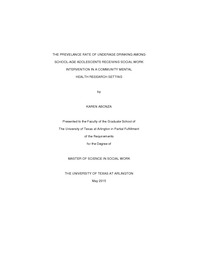
ATTENTION: The works hosted here are being migrated to a new repository that will consolidate resources, improve discoverability, and better show UTA's research impact on the global community. We will update authors as the migration progresses. Please see MavMatrix for more information.
Show simple item record
| dc.contributor.author | Abonza, Karen | en_US |
| dc.date.accessioned | 2015-07-31T22:10:12Z | |
| dc.date.available | 2015-07-31T22:10:12Z | |
| dc.date.submitted | January 2015 | en_US |
| dc.identifier.other | DISS-13118 | en_US |
| dc.identifier.uri | http://hdl.handle.net/10106/25074 | |
| dc.description.abstract | Adolescents participate in underage drinking across the United States, causing significant consequences to themselves, others, communities, and the state. Underage drinking is one of the nation's leading causes of deaths in American adolescents. The current study examines the prevalence rate of underage drinking among a clinical population. The hypothesis is that peers (peer groups and peer influence) may contribute to underage drinking greater than the impact of families encouraging alcohol. An epidemiological case record review of 100 participants from the years 2012 to 2014 was conducted at the University of Texas at Arlington's Center for Clinical Social Work (CCSW) using systematic random sample. The data suggested that the prevalence rate for the CCSW school-aged clinical population yielded to 21.4%. The prevalence rate of the CCSW was then compared to the national general population prevalence rate, which yielded to 15.8%, suggesting that clinical populations do have higher prevalence rates. | en_US |
| dc.description.sponsorship | Smith-Osborne, Alexa | en_US |
| dc.language.iso | en | en_US |
| dc.publisher | Social Work | en_US |
| dc.title | The Prevalence Rate Of Underage Drinking Among School-age Adolescents Receiving Social Work Intervention In A Community Mental Health Research Health Setting | en_US |
| dc.type | M.S. | en_US |
| dc.contributor.committeeChair | Smith-Osborne, Alexa | en_US |
| dc.degree.department | Social Work | en_US |
| dc.degree.discipline | Social Work | en_US |
| dc.degree.grantor | University of Texas at Arlington | en_US |
| dc.degree.level | masters | en_US |
| dc.degree.name | M.S. | en_US |
Files in this item
- Name:
- Abonza_uta_2502M_13118.pdf
- Size:
- 464.1Kb
- Format:
- PDF
This item appears in the following Collection(s)
Show simple item record


